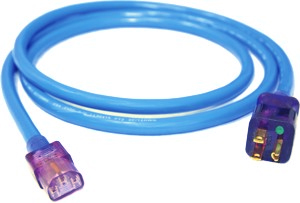|
You are reading the older HTML site
Positive Feedback ISSUE
16
Affordable Power Cords: JPS Lab
GPA2 and the DH Lab Power Plus
Power cords, speaker cables, and interconnects are both difficult and easy to review. You can almost always detect a difference between a new contender and your reference, but the difference may not be easy to define. Unlike source components, wires don't have controls, sexy structures, or lots of specs. Technical descriptions aren't needed to operate some wire and a couple of plugs. Then again, if you want to discuss the physics behind wire composition, dielectrics, shielding, grounding, etc., you will get into many tiny details. Tiny details are what separate the JPS Labs GPA2 power cord and the DH Labs Power Plus Reference Series cord.
The JPS Labs GPA2 ($195/two meters) is made from ultra-pure, finely stranded 12 AWG conductors and the highest quality dielectric. The GPA2 incorporates a custom, molded, hospital grade, 24-karat-gold-plated plug and copper alloy terminal materials (not the normal brass variety) that are hand soldered and crimped. The cord is UL/CSA safety approved.
The DH Labs Power Plus Reference Series Power Cord ($200/two meters) is constructed with the finest high-purity copper in the world. It features DH Labs' noise-canceling geometry, combined with low resistance, low inductance, 12-gauge conductors that allow for unrestricted dynamic current delivery, while keeping noise out of your system. DH Labs claims that the Power Plus reduces coloration and improves overall transparency. Each power cord was plugged straight into a power outlet that it shared with an AudioPrism Quiet Line filter. The other end was connected to my PS Audio HCA-2 power amp. After running in both cables for a couple of days, what did I hear? Both exhibited smoother highs and faster, better definition of bass lines than the stock AC cord. The sound was more cohesive, the tonality fuller, the attack faster, and the decay time longer. Most of all, the noise floor of the system was lower. Both cords exhibited definite improvements, but it was really hard to hear a difference between them. After listening to many recordings, I decided to choose a few discs to try to determine whether I preferred one over the other. The shootout went as follows:
"Ce," from Toots Thielmans, The Brasil Project II JPS Labs: The leading edge transients were faster, acoustic instruments had more wood. Toots' harmonica had more bite. DH Labs: The vocal was more natural, had more sustain, and more low-level detail. Which did I prefer? Both! It was scary how close the two cords were.
"The Lover," from Medeski, Martin and Wood, Friday Afternoon In The Universe JPS Labs: Medeski's Hammond B-3 had more bite, Martin's ride cymbal more presence. DH Labs: As the owner and occasional player of a large cowbell collection (it was strange enough when my future wife discovered I played drums, but when she found out about the cowbells….), I probably listen to this sound more than most. I'm pretty sure this was an LP Mambo Bell, and it sounded much more accurate with the DH cord. And which cord did I prefer this time? I had to give this one to the DH for the fine cowbell. (I can just hear this on Audio Asylum—"Didja hear the wingnut who writes for Positive Feedback talkin' ‘bout the cowbell, fer chrissake?)
"Dangerous Mood," from Keb' Mo, Just Like You JPS Labs: The electric guitar on this cut really stood out with the GPA2—nice and crunchy, and it really got me moving during the solo. The GPA2 communicated this tune more forcefully. I was out of my chair, air-dancing. (Most people play air guitar or air drums. When I grew up, I was always playing gigs—usually dances—so I never learned to dance.) DH Labs: The Power Plus was more pleasant on this one. Nice air, more bloom. Not as communicative, but sweeter. And this time? JPS. Jammin'. What about trying these cords with other components? Forget it. I spent some time attempting to hear a difference, but evaluating the cords using a source component or preamp in my system was nearly impossible. Both power cords offer an affordable way to enhance your system's performance. Both are recommended. Which should you choose? Use the JPS if your system tends to be on the warm side, as it has a slightly brighter presentation. Use the DH if your system is lean, as it has a slightly darker presentation. The winner? Again, a tie. Rhymes with buy. John Zurek
DH Labs
JPS |





